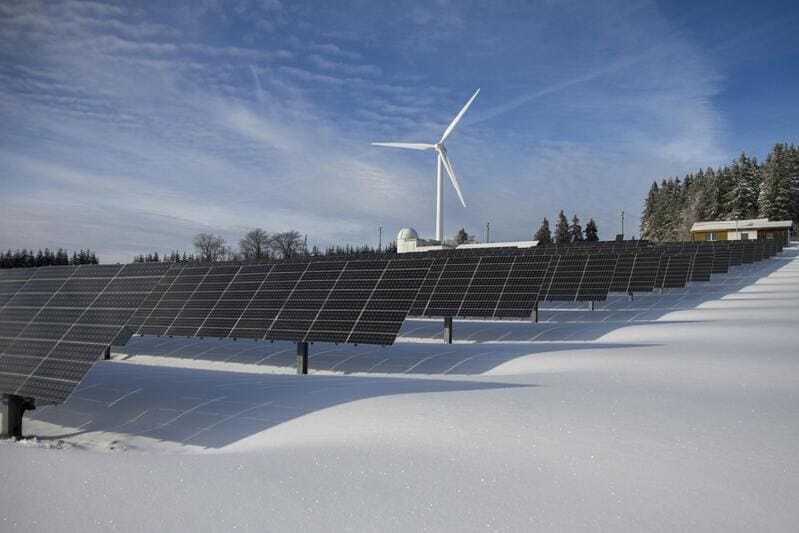Powering the Future: How Businesses Are Embracing Renewable Energy for a Sustainable World
In today’s environmentally conscious world, carbon neutrality has ascended from environmental dialogue to a pivotal goal for nations, industries, and individuals. Achieving carbon neutrality involves balancing emitted carbon with carbon offset or removal, reducing the carbon footprint to zero. Among the myriad of strategies to reach this laudable goal, the role of renewable energy stands out as both vital and transformative. As we harness the winds, waves, and sunlight, how can we ignore such abundant, clean, and powerful gifts from nature?
Contents
Renewable Energy: The Basics

Renewable energy, derived from natural processes that are continually replenished, includes sources like sunlight, wind, rain, tides, and geothermal heat. These resources differ from fossil fuels in one fundamental way: they produce no direct carbon emissions when used to generate energy, thus having a minimal impact on the planet’s carbon balance. This inherent attribute establishes renewable energy as a cornerstone in the architecture of carbon neutrality. Embracing these sources not only pivots us away from the destructive consequences of fossil fuels but also propels us toward a sustainable future. We fully commit to the energies that sustain rather than drain our world.
Examples from the Industry
Across the business landscape, many sectors are transitioning to renewable energy solutions to diminish their environmental impact. As renewable technologies become more viable and cost-effective, industries traditionally reliant on fossil fuels adapt to this shift. Companies are installing solar panels, investing in wind projects, and venturing into bioenergy and other sustainable alternatives. For example, REC commercial solar solutions illustrate how businesses can effectively integrate tailored solar energy systems into their daily operations. These systems reduce operational costs by lowering energy expenses and boost corporate reputation by demonstrating a commitment to environmental sustainability. Moreover, this strategic shift often qualifies businesses for government incentives and tax benefits, further encouraging their transition towards a greener future.
Impact on Carbon Emissions
Transitioning to renewable energy sources has a profound effect on reducing global carbon emissions. When we replace coal-fired power plants with wind farms or solar panels, the immediate benefit is a substantial decrease in carbon emissions. Every kilowatt-hour of electricity generated through renewable sources is a stride away from carbon-intensive fossil fuel usage. The more we integrate renewable energy into our power grids, the closer we achieve a balanced carbon equation. By investing in these clean energy solutions, we not only foster a healthier environment but also set a precedent for future generations. This movement towards renewables is not just an environmental choice; it’s a testament to our commitment to a sustainable and thriving planet.
Economic Incentives and Challenges
The shift towards renewables is not only environmentally imperative but economically beneficial. Renewable energy projects create jobs, stimulate local economies, and, through technological innovation, reduce the cost of energy production. While this transition presents challenges, the initial investment for renewable energy infrastructure, though high, pays dividends in the long run, and the variability of resources like solar and wind can affect reliability. However, battery storage technology and grid management advances are rapidly addressing these issues, making renewable sources more stable and efficient. These technological advancements ensure that renewable energy can meet our demands consistently, proving that the path toward green energy is both viable and essential for our future.
Long-term Sustainability
Adopting renewable energy is about more than immediate carbon reduction. It also aligns with long-term sustainability goals. Renewable resources, being nearly inexhaustible, offer a perpetual energy solution crucial for sustainable development. This long-term perspective is vital for planning and investment, encouraging governments and businesses to prioritize renewables in their energy portfolios. As we shift towards these sustainable options, we ensure energy security and resilience against economic and environmental shocks. Moreover, integrating renewables significantly reduces global dependency on volatile fossil fuel markets, fostering a more stable and predictable energy future.
Consumer Influence

As consumers become more environmentally savvy, their choices increasingly influence market trends. People opt for products and services from companies that are committed to sustainability. This consumer behavior shift has prompted businesses to adopt green practices, including renewable energy, thus further propelling the market toward carbon neutrality. The growing demand for eco-friendly products encourages even more firms to innovate and improve their sustainability measures. Consequently, this virtuous cycle helps achieve carbon neutrality and enhances corporate responsibility and consumer trust.
Global Cooperation
Achieving carbon neutrality on a global scale requires cooperation among nations. International agreements and collaborations facilitate the sharing of technology, financial resources, and strategic frameworks necessary for a coordinated approach to carbon reduction. Countries with advanced renewable technologies can support developing nations, creating a collaborative effort that benefits the global community. This international partnership accelerates the adoption of clean energy and promotes equity in access to these technologies. By pooling resources and expertise, countries can overcome barriers more effectively and make substantial progress toward shared environmental goals.
Future Outlook
Looking ahead, the trajectory toward renewable energy looks promising. Innovations in technology are making renewables more efficient and more accessible. With ongoing investment and policy support, renewable energy can become the backbone of a carbon-neutral future, ensuring a cleaner, more sustainable planet for future generations. As we continue to advance and refine these technologies, the costs associated with renewable energy will likely decrease, making it even more competitive with traditional energy sources. This progress benefits the environment and strengthens the economic stability of nations embracing these sustainable practices.
Conclusion
Renewable energy is not just an alternative to fossil fuels; it’s a necessary evolution in our energy consumption paradigm, essential for achieving carbon neutrality. The journey is complex and fraught with challenges, but the collective benefits of cleaner air, economic growth, and a sustainable future make it a path worth pursuing. As technology advances and global cooperation strengthens, the goal of a carbon-neutral world becomes increasingly attainable, ensuring a healthy planet for future generations. This progress propels us not only towards environmental health but also towards a new era of energy independence. When so much is at stake, can we overlook the imperative of shifting to renewable energy?
